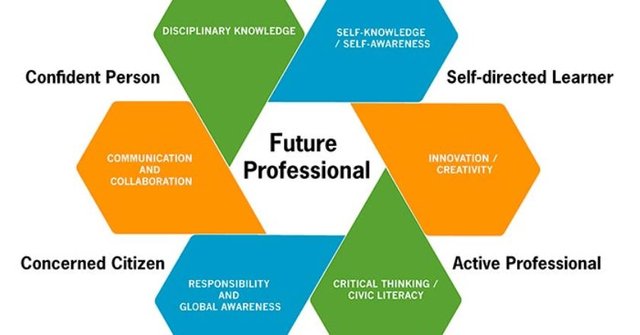Building e-based literacy for vocational education and training students

The use of Internet within educational settings is that the term 'literacy' is mandatory
Be a great deal to add new skills and reflect old and new subdivision.
The challenge for practitioners is to make new media meaningful and empowered
It is more focused on students when communicating with hyper text
In the past two decades, a little research has understood in hyper text
This study investigated and compared the effectiveness of metacognitive
reading comprehension strategies training on students’ comprehension when reading
hypertexts with linear structure containing text, picture or audio links. It was
predicted that training students to monitor their comprehension would result in
enhanced reading comprehension for a hypertext. In order to verify the hypothesis for
the study, pretest, three training sessions and post-tests were conducted with the first
year Diploma students studying within the Department of Horticulture and
Environmental Science. The results indicated that training to apply metacognitive
strategies enhanced comprehension in the hypertext context.
Introduction
Rapid changes in information and communication technology (ICT) have reshaped
the meaning of "literacy" and the role of the teacher. The new era of web literacy has
not evolved without its critics, some suggesting that it signalled the end of print based
materials and the literacy skills associated with them. However, Kellner (2002) has
argued that this technological revolution brings the opportunity to reshape literacy
skills in education to better serve democratic needs and to prepare citizens for a global
multicultural world. Kellner (2002) stresses also that the debate about the role of
computers in education should be about how they are used in education not whether
they are good or bad.
The use of ICT in learning and teaching will continue as new technological tools are
made available for the purpose of education. Policies that promote the use of these are
regarded as innovative and important skills not only to facilitate education outcomes,
but also skills needed for the workplace and lifelong skills in general. Some ICT such
the Internet, email and digital media are now used routinely in many institutions
across all sectors, primary, secondary and tertiary.
Since the early 1990s it has been a Victorian State government educational policy to
introduce technology into the curriculum and equip students with computer
knowledge (Snyder, 1997). In tertiary institutions where online learning is a feature of
many courses, learning management systems such as WebCT have been adopted
widely, and in some institutions having a component of online delivery has become
mandatory for all courses.
Verezub, Grossi, Howard and Watkins 327
A new medium brings with it new challenges and opportunities for teachers and
learners. For example, for educational theorists the changes brought about by using
technology in education means the term "literacy" must be broadened to encompass
these new skills or reflect the merging of old and new literacies. For practitioners, the
challenge lies in making the new media meaningful and empowering to students.
This study investigated and compared the effectiveness of training on the reading
comprehension of students when reading hypertexts with linear structure. In
particular, the influence of training in metacognitive reading comprehension strategies
on hypertext comprehension was evaluated, anticipating that training students to
monitor their comprehension would result in enhanced reading comprehension for
hypertext.
Literature review
Hypertext and skills required to read critically
There is a need for new skills required to decode texts presented in cyberspace but in
some cases it is the amalgam of old and new. Burbules and Callister (1996, cited in
Sutherland-Smith 2002a, p. 665) described reading on the Internet as an activity which
‘extends thinking skills beyond the hierarchical, linear-sequential model that serves so
well in the world of print media’.
Studies concur that hypertexts are different from traditional texts in terms of
organisational patterns, multimodilty and linearity (Tindale, 2005). The effects these
patterns have on the reader differ according to the ability of the reader. Reading
hypertexts is not a generic activity. The literature shows that units within the Internet
such as homepages and the way readers choose and follow links are parts of the
cyberspace reading experience (Thurstun, 2004; Burbules, 1997).
Burbules (1997) pointed out that whilst the act of reading in itself is the same,
hypertext reading is carried out in a different context. He called the act of reading in
cyberspace "hyperreading" and the different context "the pragmatics of reading"
(Burbules, 1997). Even though information is referred to as "pages", he pointed out that
the speed, structure and presentation of webtexts are vastly different to traditional
print texts. He also said that "surfing" the web indicates a quick skimming of texts in
order to determine what is important. This is what Sutherland-Smith called the
"snatch-and-grab" technique of reading (Sutherland-Smith, 2002a).
In general, hypertexts are described as being non-linear, even though there are
hypertexts which are organised similarly to print texts. The information can be reached
in different sequences, using links. Hypertexts can also be interactive, giving the reader
much more control over reading and understanding than occurs with traditional texts.
Indeed, in many cases the reader can become the writer by contributing to the text.
The visual element in web texts is another typical feature which adds to the complexity
of reading in this context (Sutherland-Smith, 2002a, p. 665). Web literacy has been
defined as a term for "finding, scanning, digesting, and storing Internet information"
(Sutherland-Smith, 2002a, p. 663). Snyder (2002) states that for the first time in history,
literacy encompasses written, oral and audiovisual modalities. A further dimension of
hypertexts is that they can be updated regularly or frequently so the reader encounters
Vote for vote
https://steemit.com/art/@ratnadip123/woman-performs-blessings-of-the-nature
)